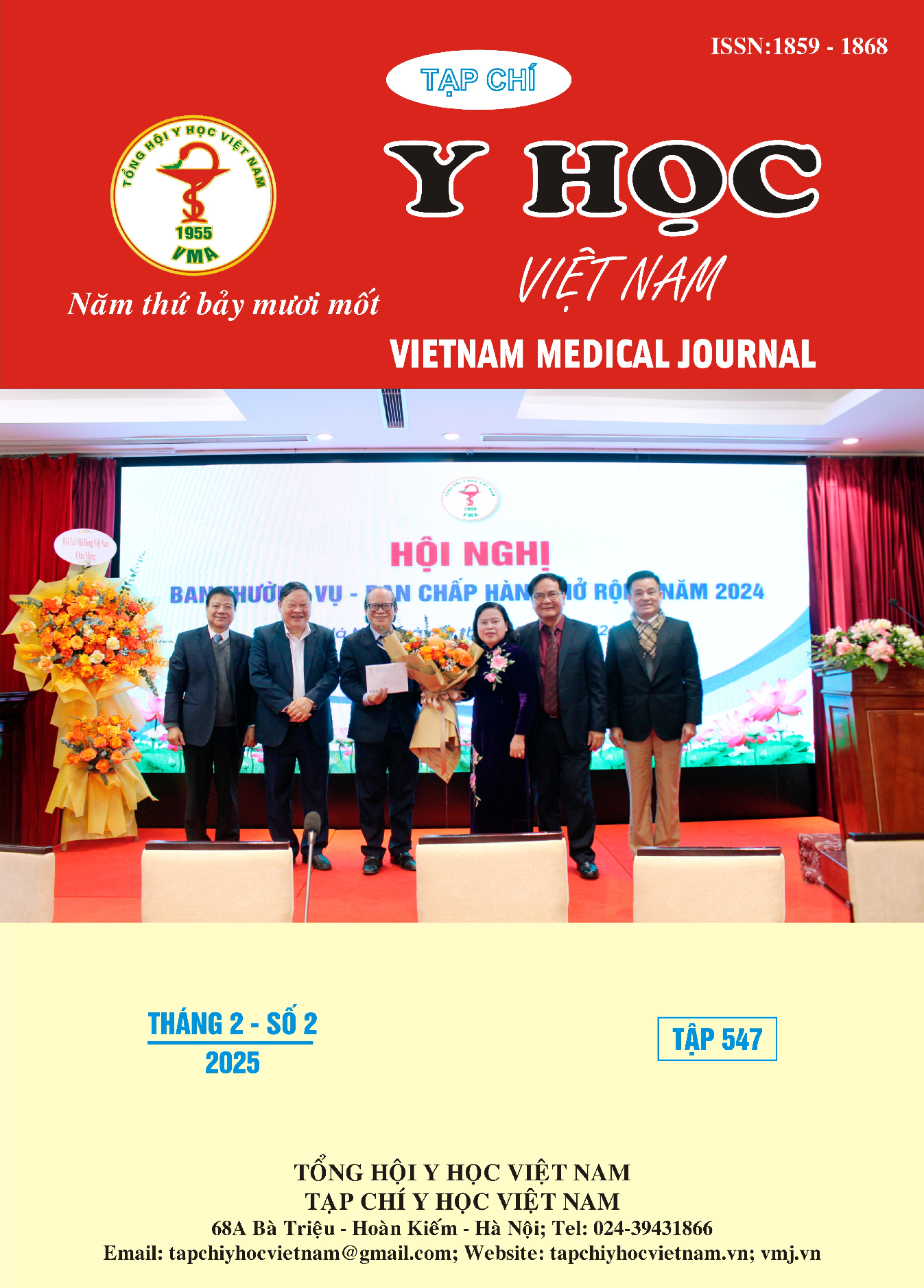STUDY ON SEQUENCE ANALYSIS TO DETERMINE MUTATIONS AND EXPRESSION LEVELS OF NUCB2 AND SLC2A2 GENES RELATED TO NESFATIN-1 CONCENTRATION IN PATIENTS WITH TYPE 2 DIABETES
Main Article Content
Abstract
Objective: To determine the gene expression levels and analyze sequencing to identify mutations in certain genes associated with nesfatin-1 levels in patients with type 2 diabetes. Subjects and Methods: The study was conducted with 139 patients with type 2 diabetes in the patient group and 75 subjects in the control group at 198 Hospital; where nesfatin-1 levels were quantified. The methods employed in the study included gene expression analysis using Real-time PCR and Sanger sequencing. Results: The expression levels of the NUCB2 and SLC2a2 genes showed significant changes when comparing the type 2 diabetes patient group with the control group (p<0.05): The NUCB2 gene expression level decreased by about 18-22% compared to the healthy control group. The SLC2A2 gene expression level increased by 121% when compared to the control group. Six mutations were identified in the NUCB2 gene sequence across 6 samples out of the total 10 samples sequenced (rs1941384932 G/A; rs1941406012 G/A; rs945974367 C/A; rs1239838466 G/C; Rs1941390294 G/C; and Rs1476160930 GG/G). Among these, mutations in the intronic region included rs1941384932 G/A, rs1941390294 G/C, and Rs1476160930 GG/G. Three SNP points in the exon region were: rs1941406012 G/A, rs945974367 C/T, and rs1239838466 G/C. In the SLC2a2 gene region, 06 SNPs were recorded in two groups of patients: newly diagnosed and currently treated (rs756099063 T/A; rs2108232309 A/G; rs121909745 C/A; rs201322542 G/A; rs754406000 T/C; and rs370761728 A/T), with 3 points in the exons and 3 points in the introns. Conclusion: This study provides important initial data regarding the presence of SNPs and gene expression levels of NUCB2 and SLC2A2 in patients with type 2 diabetes, related to nesfatin-1 levels in these patients. However, to determine the exact correlation between these two gene regions, further expanded and in-depth studies are needed.
Article Details
Keywords
nesfatin-1; Type 2 diabetes; NUCB2 gene; SLC2A2 gene; newly diagnosed; treated.
References
2. Tran HD, Tran TN. Diabetes Recommendations: Epidemiology, classification, and diagnosis. J Vietnam Diabet Endocrinol Soc 2016;5-12.
3. Guo, Y., Liao, Y., Fang, G., Dong, J. and Li, Z., 2013. Increased nucleobindin-2 (NUCB2) transcriptional activity links the regulation of insulin sensitivity in Type 2 diabetes mellitus. Journal of endocrinological investigation, 36,883-888.
4. Laukkanen, O., Lindstrom, J., Eriksson, J., Valle, T.T., Hamalainen, H., Ilanne-Parikka, P., Keinanen-Kiukaanniemi, S., Tuomilehto, J., Uusitupa, M. and Laakso, M., 2005. Polymorphisms in the SLC2A2 (GLUT2) gene are associated with the conversion from impaired glucose tolerance to type 2 diabetes: the Finnish Diabetes Prevention Study.Diabetes, 54(7),2256-2260.
5. Sansbury, F.H., Flanagan, S.E., Houghton, J.A.L., Shuixian Shen, F.L., Al-Senani, A.M.S., Habeb, A.M., Abdullah, M., Kariminejad, A., Ellard, S. and Hattersley, A.T., 2012. SLC2A2 mutations can cause neonatal diabetes, suggesting GLUT2 may have a role in human insulin secretion. Diabetologia, 55, 2381-2385.
6. Şakalar, E. and Abasıyanık, M.F., 2012. The devolopment of duplex real-time PCR based on SYBR Green florescence for rapid ıdentification of ruminant and poultry origins in foodstuff. Food Chemistry, 130(4), 1050-1054.
7. Minton, J.A., Flanagan, S.E. and Ellard, S., 2011. Mutation surveyor: software for DNA sequence analysis. PCR Mutation Detection Protocols, 143-153.
8. Goebel-Stengel, M. and Wang, L., 2013. Central and peripheral expression and distribution of NUCB2/nesfatin-1. Current pharmaceutical design, 19(39), 6935-6940.
9. Holman, G.D., 2020. Structure, function and regulation of mammalian glucose transporters of the SLC2 family. Pflügers Archiv-European Journal of Physiology, 472(9),1155-1175.
10. Norton, L., Shannon, C.E., Fourcaudot, M., Hu, C., Wang, N., Ren, W., Song, J., Abdul‐Ghani, M., DeFronzo, R.A., Ren, J. and Jia, W., 2017. Sodium‐glucose co‐transporter (SGLT) and glucose transporter (GLUT) expression in the kidney of type 2 diabetic subjects. Diabetes, Obesity and Metabolism, 19(9),1322-1326.


